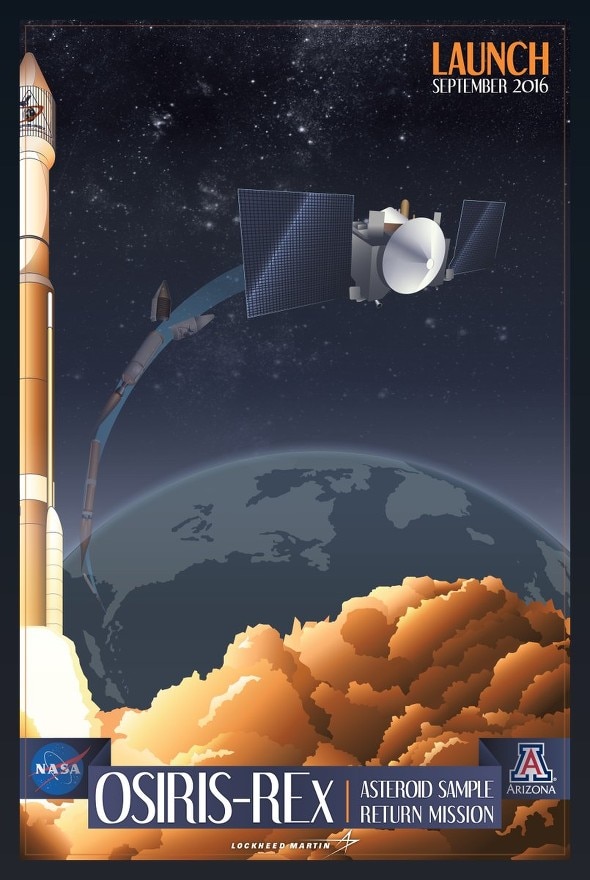Create a free profile to get unlimited access to exclusive videos, sweepstakes, and more!
Thursday Night, NASA Launches a Mission to Sample an Asteroid ... and Bring a
Piece of It Back to Earth

On Thursday evening, NASA will attempt the launch for an ambitious mission: OSIRIS-REx, a spacecraft that will go to an asteroid, collect a sample, and return it to Earth.
Yeah. This mission is cool.
OSIRIS-REx is the tortured acronym for the Origins, Spectral Interpretation, Resource Identification, Security-Regolith Explorer. The launch window opens Thursday at 19:05 Eastern time (23:05 UTC). The vehicle is an Atlas V, which is a reliable rocket. If the launch is delayed, that’s not a problem: The launch window is 34 days long! So if they can’t launch on time, they have plenty of leeway.
You can watch the launch live on NASA TV on their UStream HD channel.
The target is the asteroid 101955 Bennu, a roughly 500 meter-wide rock on an orbit that gets pretty close to Earth; in fact it’s classified as a near-Earth object, and has a very small but non-zero chance of impacting us in a couple of hundred years. I’ll note there’s no need to worry yet; trying to predict an asteroid’s position more than a decade or two in the future is difficult, so it’s far more likely it’ll miss us. In fact, OSIRIS-REx will be able to nail down the asteroid’s orbit and determine how big a threat it is simply by catching up to it and following it.
The spacecraft is loaded with instruments, including medium and high resolution cameras, mineralogical mappers, and, most excitingly, a sample return package called the Touch-and-Go Sample Acquisition Mechanism, or TAGSAM. Let me explai n…
After a four-year trip to Bennu (including one flyby of Earth to add energy to the probe’s trajectory), it will go into orbit around the asteroid and begin mapping the surface (it will also look for any orbiting moons and even plumes of material, should Bennu turn out to have any cometlike characteristics). It will search for a good spot, and on July 4, 2020, OSIRIS-REx will approach Bennu slowly at a mere 10 centimeters per second; a mosquito could easily outpace it. TAGSAM has a long arm that will be extended, pointing at the asteroid’s surface. When it senses contact, a jet of pure nitrogen gas will be shot out to stir up the dusty surface. Material will get caught in a sample collector, which has the capacity to hold from 60 grams up to two kilos of asteroidal dust and grit. If the first attempt doesn’t work, two more will be made. After each the spacecraft will recoil at slow speed, so it can stop itself and try again, hopefully catching enough stuff to make the trip worth it.
The material will be stowed in a return capsule, and then the whole spacecraft will return to Earth. Three years after collecting its sample, in 2023, OSIRIS-REx will approach our home planet, eject the return capsule with the bits of Bennu in it, then fire its engines to go on a safe orbit around the Sun.
The capsule will use a heat shield to slow its decent, then deploy a parachute and land in the Utah desert in September 2023, where some very excited scientists will collect it, bring it to a lab, and study the heck out of what they find.
And they should be excited. Bennu is a carbon-rich asteroid, and we know these types of rocks have organic compounds in them, including materials like amino acids that are the building blocks of life as we know it. It’s possible that the precursors for life on Earth literally fell from the skies billions of years ago! By studying these samples we’ll learn a lot about what asteroids are like.*
That’s good for a lot of reasons, including self-interest: Like I said, Bennu is a near-Earth asteroid, and we may need to push it into a safe orbit someday. If it’s not a solid object, but instead deeply fissured or a pile of rubble held together by its own gravity, we need to know that so we’ll know how to best deflect it.
I like asteroids when they stay out in space. When they hit us, not so much. I’m all for us learning as much as we can about them for the science, for the wonder, for the joy of learning. But I also think we should do it so we can ensure we can keep doing it.
The first step in this journey is the rocket launch carrying OSIRIS-REx to Bennu. It will be exciting to watch it, knowing the cargo it carries and what we’ll learn when it gets back.
*In 2010 the Japanese probe Hayabusa returned to Earth with a sample of the asteroid Itokawa, so this isn’t the first time this sort of thing has been done. But the more the merrier.


























